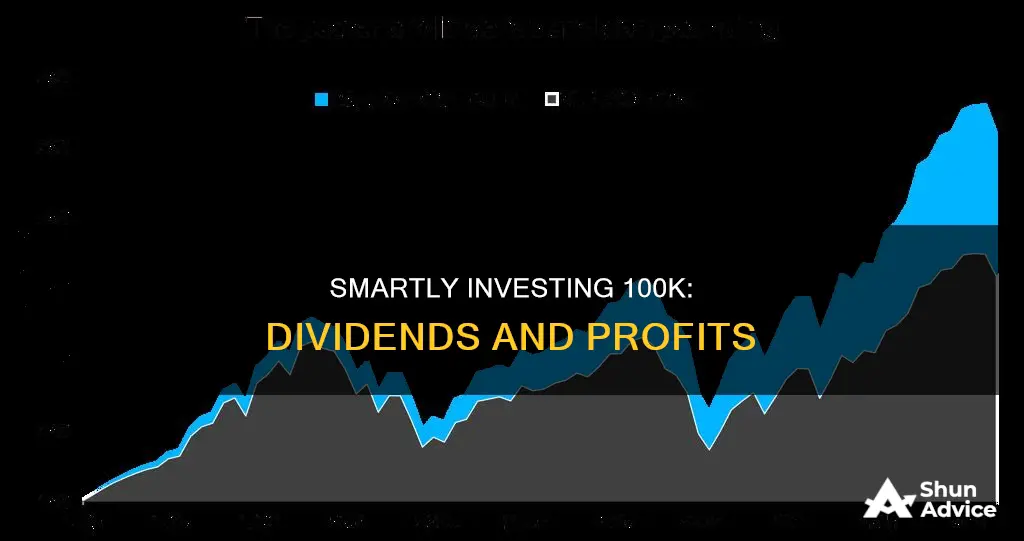
Investing $100,000 in dividend stocks is a popular way to generate passive income. The amount you can earn from $100,000 invested in dividend stocks varies depending on the dividend yield, which is the dividend per share divided by the stock price. Higher yields typically offer more income but may also come with higher risks. To calculate dividend yield, divide annual dividend payments by market price per share. For example, if you received $100 in dividends from a share worth $1,000, the dividend yield would be 10%, indicating a 10% return in dividends on your investment for the next year.
When selecting dividend stocks, it is important to consider the company's history of dividend payments, financial stability, and industry performance. Diversifying your investments across different sectors and industries can also reduce risk.
What You'll Learn

Diversify your investments
Diversifying your investments is a fundamental principle of successful dividend investing. It may be tempting to put all your money into a few companies that look promising, but if those companies or sectors experience a downturn, you could lose a lot of money.
By spreading your investments across different sectors and industries, you reduce the risk of losing money. This approach is called diversification, and it means that you give yourself exposure to many sectors, increasing your chances of success.
For example, you could invest $10,000 in one company and $1,000 in ninety more companies, or, to allocate your investments more evenly, you could invest $500 in 200 companies. Either way, you will have a stock portfolio earning dividends annually.
When selecting companies to invest in, it is important to look at their history of paying dividends, how solid their finances are, and whether their industry is doing well. It is also a good idea to choose companies with a long-term perspective. Look for companies with strong fundamentals and a proven track record of weathering market fluctuations. A history of consistent dividend payments and a commitment to maintaining or increasing dividends over time is also crucial.
Additionally, consider the company's ability to generate consistent cash flow. Analyze their financial statements to ensure their operating cash flow can consistently cover dividend payments. Companies with diversified revenue streams, recurring business models, and time-tested products or services are better suited to maintain stable cash flow, even during economic downturns.
By diversifying your investments and choosing reliable companies with strong financials, you can build a resilient and profitable dividend investment portfolio.
Indian Investors: Your Guide to NFT Investing
You may want to see also

Reinvest your dividends
Reinvesting your dividends is a great way to build wealth over time. Dividend reinvestment plans (DRIPs) allow you to automatically reinvest your dividends to purchase additional shares of a company's stock. This can be done at no extra cost, with no commissions or brokerage fees for the shares that you buy, and you can even buy fractional shares, which brokers usually don't allow.
DRIPs are a good strategy because they are cheap, easy, and flexible. They are also a form of dollar-cost averaging (DCA), as you buy shares on a regular basis—every time you get a dividend.
For example, say you invest $20,000 in a company with a stock price of $20, so you get 1,000 shares. At the end of the first year, you receive a dividend payment of 50 cents per share, which comes out to $500. The stock price is now $22, so your reinvested dividend buys an extra 22.73 shares. At the end of the second year, you earn a dividend of 55 cents per share, which is now on 1,022.73 shares, so your total dividend payment is $562.50. The stock price is now $24.20, so reinvesting this dividend buys an additional 23.24 shares. You now own 1,045.97 shares, valued at $25,312.47.
After just three years of stock ownership, your investment has grown from 1,000 shares to 1,069.55 shares. And due to the stock’s gains, the value of your investment has grown to $28,471 from your initial $20,000.
However, reinvesting your dividends may not always be the right choice. If you are at or near retirement and need the income, or if the underlying asset is performing poorly, it may make more sense to take the cash. It's important to remember that stocks may reduce or stop paying dividends, so be sure to check in with a financial advisor if you have any questions or concerns about reinvesting your dividends.
Smart Investment Strategies for 6 Lakhs in India
You may want to see also

Understand dividend yield
Dividend yield is a ratio that shows how much a company pays out in dividends each year relative to its stock price. It is a financial ratio that tells you the percentage of a company's share price paid out in dividends annually.
The formula for calculating dividend yield is:
Dividend Yield = Dividends Per Share / Price Per Share
For example, if a company's share price is $50 and it pays annual dividends of $1.50 per share, the dividend yield is 3%. This means you would earn 3% in dividends per year from an investment in the company's stock, assuming the dividend payout remained the same.
Dividend yield is an important metric for investors as it helps them understand their return on investment. It is particularly relevant for those seeking a steady stream of income from their investments, such as retirees. However, it is not the only factor to consider when evaluating investment options. Other metrics such as performance against major benchmark indexes and corporate fundamentals should also be taken into account.
It is also important to note that a high dividend yield may not always be positive. It could indicate that a company's stock price has been falling or that dividend payments have been increasing at a higher rate than the company's earnings. Conversely, a declining dividend yield due to a higher stock price is not necessarily negative, as it could indicate increased investor confidence in the company.
When evaluating dividend yields, it is recommended to compare yields offered by companies within the same industry or category, as yields can vary significantly across sectors.
Asset Managers: Where Do They Invest Their Money?
You may want to see also

Calculate portfolio dividend yield
To calculate portfolio dividend yield, you must take all your investments into account.
Firstly, calculate the total annual dividend payout from all your investments. For example, if you have 10 investments of $10,000 each, and five of these provide a $500 dividend yield, two provide a $2,000 yield each, one provides a $3,000 yield, and the last two fail to pay dividends, your total annual dividend payout is $9,500.
Next, divide this total by the total amount you have invested. Using the example above, you would divide $9,500 by $100,000, which equals 0.095, or 9.5% as a percentage. Therefore, your portfolio dividend yield is 9.5%.
The formula for calculating dividend yield is:
Dividend Yield (%) = Dividend Per Share (DPS) ÷ Current Share Price
This can be calculated on an annualised basis by multiplying the latest quarterly dividend amount per share by four.
Adjusting Your Investment Portfolio: Strategies for Success
You may want to see also

Evaluate company health
Evaluating a company's financial health is a crucial step in making an informed investment decision. Here are four to six paragraphs detailing various aspects to consider when evaluating a company's health before investing:
Financial Performance and Health
First, analyse the company's financial statements, including the income statement, balance sheet, and cash flow statement. Assess the company's revenue and profitability trends over time. Look for consistent revenue growth, profitability, and a strong balance sheet with low debt levels and healthy cash reserves. A company with a strong financial position and consistent financial performance is more likely to be a stable investment.
Debt and Liquidity
Review the company's debt level and liquidity position. A company with high debt levels may be riskier, as it could struggle to meet its financial obligations. Assess the company's debt-to-equity ratio and current ratio to understand its ability to manage debt and liquidity. A debt-to-equity ratio of less than 1.0 is favourable, indicating the company has more equity than debt. The current ratio measures the company's ability to pay off current liabilities with current assets.
Business Model and Industry
Understanding the company's business model and industry is vital. Evaluate the company's competitive position, growth prospects, and potential industry risks. A company with a strong market position, competitive advantages, and positive industry trends is more likely to sustain dividends and growth. Assess whether the company has a diverse range of products, a solid customer base, and a competent management team.
Cash Flow
Cash flow is critical to a company's financial health and day-to-day operations. Analyse the company's cash flow statement to understand its cash inflows and outflows. A company with positive cash flow has more cash coming in than going out, which is generally favourable. Ensure the company's operating cash flow can cover dividend payments and other financial commitments.
Competitive Advantages and Management
Assess the company's competitive advantages, such as brand recognition, economies of scale, and intellectual property. A strong brand and unique offerings can help maintain profitability and long-term growth. Additionally, evaluate the quality of the company's management team. A competent and experienced management team is more likely to make sound decisions and drive the company's success.
Investor Sentiment and Growth Prospects
Finally, consider the investor sentiment and the company's future growth prospects. A company that garners positive attention and confidence from investors is likely to have stable stock market performance. Assess the company's potential for future expansion and long-term investment returns.
Investment Management: May's Grand Junction Strategy
You may want to see also
Frequently asked questions
This depends on the dividend yield and how well the companies you invest in perform. With a thoughtful and strategic investment strategy, your potential earnings can range above 7%.
You can calculate dividend yield by dividing annual dividend payments by market price per share. For example, if you received $100 in dividends from a share worth $1,000, the dividend yield is 10%, indicating a 10% return in dividends for the following year.
A portfolio dividend yield is the average dividend yield from all the stocks you hold. It helps you understand how much you are earning from your investments and is useful for planning and deciding where to invest next.
Look for companies with a long history of paying dividends, strong finances, and a stable industry position. Evaluate their dividend history, financial stability, payout ratio, and industry health.
Diversification is key—spread your investments across different types of companies to reduce risk. Consider reinvesting your dividends to buy more shares and boost your investment growth. Don't forget about taxes, as they will impact your overall earnings. Stay informed about market trends and regularly assess your holdings to make better investment decisions.







